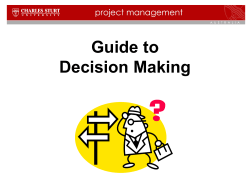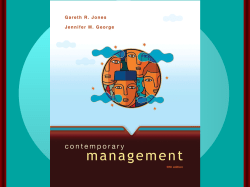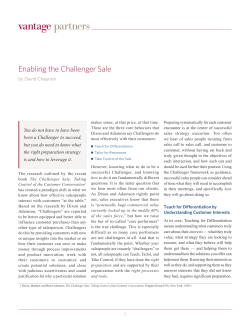
How to demonstrate Additionality? Presented by: Veronique Bovee June 1st, 2005
How to demonstrate Additionality? Presented by: Veronique Bovee June 1st, 2005 Additionality KP/MA: “The emission reductions of the project must be additional to any that would occur in absence of the project” What does this mean? Does it refer to emissions reductions or the project? Demonstrate intent to reduce GHG emissions How to demonstrate this? Baseline Scenario Emissions: tCO 2/MWh Business as Usual scenario Project Scenario Emission reductions 2012 Guidance from EB a. A flow-chart or series of questions that lead to a narrowing of potential baseline options; and/or b. A qualitative or quantitative assessment of different potential options and an indication of why the non-project option is more likely; and/or c. A qualitative or quantitative assessment of one or more barriers facing the proposed project activity; and/or d. An indication that the project type is not common practice in the proposed area of implementation, and not required by the host country legislation/regulations. Concept of the Consolidated Tool for Demonstration of Additionality Step 0 – Preliminary screening of projects started after 1-1-2000 and prior to 31-12-2005 PASS Step 1 – Identification of Alternatives PASS Step 2: Step 3: – Investment Analysis – Barrier Analysis PASS Step 4 – Common Practice analyse similar activities and compare PASS Step 5 – Impact of CERs of project on barriers Step 2/3 Project is Additional First step of Additionality Step 0 – Preliminary screening of projects started after 1-1-2000 and prior to 31-12-2005 Only relevant for projects that want to start generating CERs before project is registered with the CDM EB Only relevant for projects with starting date between 1 January 2000 and date at which first CDM project was registered with the EB If start of construction of CDM project after 18, November 2004 go directly to step 1 Need to provide evidence that CDM was considered in decision making from the start. How? Host country has been contacted for approval PIN or PDD submitted Minutes of meetings in which CDM is discussed Offering Memoranda or Cash flow analysis showing CDM value Example Step 0 Biomass project submitted PIN and PDD in 2003 and started operations in September 2004 Can indicate that CDM was taken into account from project eligibility stage Can claim CERs from September 2004 if the project is registered with the CDM EB before December 2005 Question Can I develop a landfill gas project that captures gas and started to generate electricity in March 2004 as a CDM project, now I found out that there is a value for CERs? Can I develop a project that started operations in March 2005 as a CDM project? Second step of Additionality Step 1 – Identification of Alternatives Define plausible alternatives to the project activity, including: proposed project without CDM Continuation of current situation Alternative to the project that deliver the same output The alternatives should be realistic and available to the project developer or similar project developers. Check whether alternatives are in compliance with existing legally binding regulations Example Step 1 If developer of landfill gas to energy project, define alternatives for both capturing of the gas as well as production of electricity (own use of sold to grid?). Alternatives for similar project developers being landfill managers include not capturing the gas, capturing the gas and flare, incineration. Alternatives for producing electricity include production of gas fired or coal fired by IPPs. Check against regulations in Malaysia capturing of gas is not required and the alternative of uncontrolled release of methane from a landfill is thus in compliance with the national regulations Impact Policy and Regulations on Additionality Decision Executive Board Distinct between Policies and Regulations that give comparative advantages and mandatory regulations by local or national authorities Policy and regulations that give comparative advantages to less carbon intensive technologies implemented since November 2001, do NOT have to be taken into account in the baseline. Same for regulations that give comparative advantages for more carbon intensive technologies, implemented since 1997. Incentives for more carbon intensive technologies introduced before the adoption of the Protocol have to be taken into account However, not clear on how to consider mandatory regulations when demonstrating additionality Question What would be the realistic alternatives if I would develop a biomass cogeneration project? The Malaysian government is providing subsidies for energy efficiency measures. Can my project still be eligible under the CDM if I apply such energy efficiency measures? Step 2 – Investment analysis Step 2 – Investment Analysis Indicate the proposed project is economically or financially less attractive than alternatives Do this analysis without accounting for the revenues of CERs Can do this using IRR, cost benefit ratio or unit cost of service Select the indicator and calculate and compare the financial indicators with other identified alternatives Carry out sensitivity analysis Present all assumptions and analyses used in a transparent way Example Step 2 For a landfill gas flaring project, it can easily be demonstrated that there will be no revenues without the CDM For a biomass electricity project that is connected to the grid, the project can be compared with coal fired or gas fired power plants using their IRR or costs per KWh of electricity produced. Make assumptions on investments costs, O&M costs, lifetime of the equipment etc. for the identified alternatives. For IRR it is also possible to use government bond rates and add % for specific risks Step 3 – Barrier analysis Step 3 – Barrier Analysis Identify technical, investment, institutional or other barriers Provide evidence of the existence of the barrier Indicate that the identified barrier is not a barrier for alternatives identified Mainly used in stead of Step 2. Does not have to be used in addition of Step 2, but can be Example Step 3 Barrier of a new technology for POME biogas projects – difficult to find investors For energy efficiency measures it could be indicated that it is difficult to get board approval to introduce the measures Step 4 – Common Practice Analysis Step 4 – Common Practice Analysis Analyse similar projects already implemented in region/country A project is considered similar if it is in the same country or region Of a similar scale In a comparable regulatory framework and investment climate Demonstrate why and how your project is different from these projects and why the barriers identified for your project are not applicable to the identified similar projects Example Step 4 Assume a hydropower project. The project needs to be compared against other already operational hydropower projects My project may need CDM because other hydro are developed by TNB and I am an IPP. Or because all hydro is of 25 MW and your project is 5 MW. I can indicate that it is more difficult for my IPP to develop the project than for others, since I am a small local project developer without any international investor in place. Question In Malaysia, there is already a landfill gas to electricity project operational without use of the CDM. Can I develop my landfill gas to electricity project using CDM? What if more than 5 of such projects are already operational? Final Step of the Additionality Tool Step 5 – Impact of CDM Explain how the CDM benefits will alleviate economic hurdles and other barriers Examples of benefits given: - Revenues of the sales of CERs - Can attract new players who will not be exposed to same risk anymore - May result in acceptance of lower IRR for this project type - Reduces exchange risk NOTE: There are simplified requirements for small scale projects. Any more questions?
© Copyright 2025




















![This article was downloaded by: [110.3.244.32] Publisher: Taylor & Francis](http://cdn1.abcdocz.com/store/data/000204525_1-f92587b0571cf439c3dee561743ddb4e-250x500.png)
